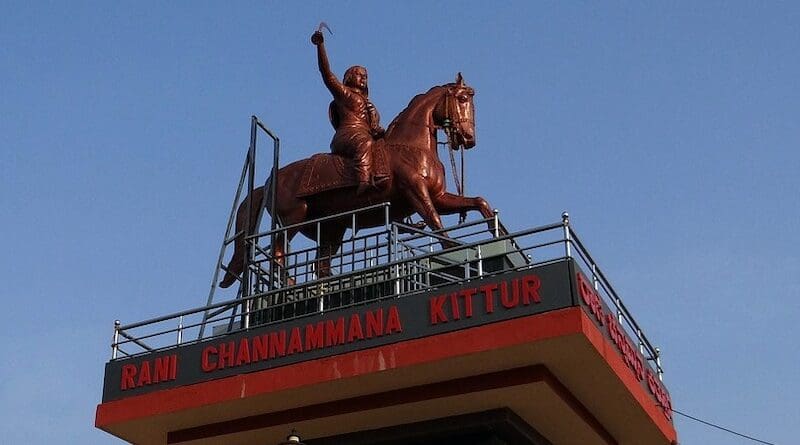First Indian Queen To Fight Against British Rule: Rani Of Kittur – OpEd
By Patial RC
Why Rani of Kittur? I am a judge in the debates ‘Women in the Armed Forces.’ During the address to the post graduate students after the debate I generally talk about the ancient legendary women warriors and stated that we only talk about the north Indian warriors like Rani Jhansi and others and the southern Indian warriors like Rani of Kittur are neglected. Majority students being from North India are unaware of her name leave alone knowing about her exploits against the East India Company.
Rani of Kittur is one of the lesser known mortals, seldom written or talked about but was great in her own way because she gave her entire life for the freedom of Kittur a former princely state in Karnataka. She was the first Queen to fight against the British Rule. She has become a folk hero of Karnataka and became a symbol of the independence movement in India.
She led her armed forces against the East India Company in 1824 in defiance of the Doctrine of Lapse in an attempt to maintain Indian control over the region, because there was no male heir. She was defeated in the third war and died imprisoned. The resistance ended with her martyrdom and she is remembered today as one of the earliest Indian rulers to have fought for independence. Along with Rani Abbakka Keladi Chennamma and Onake Obavva. Rani Abbakka Chowta was the first Tuluva Queen of Ullal who fought the Portuguese in the latter half of the 16th century. Rani Kittur is much venerated in Karnataka as an icon of bravery and women’s pride.
Rani Kittur Chennamma was born on 23 Oct 1778, in Kakati, a small village in the present Belagavi District of Karnataka. She belonged to the Lingayat community and received training in horse riding, sword fighting and archery from a young age. She was married to Raja Mallasarja of the Desai family at the age of 15.
Fight to retrieve supremacy of Kittur from the British
Rani Kittur’s husband died in 1824, leaving her with a son who also died the same year. Rani Chennamma was left with the state of Kittur and an uphill task to save it from the British. Following the death of her husband and son, Rani Chennamma adopted Shivalingappa in the year 1824 and made him the heir to the throne.This annoyed the East India Company, who ordered Shivalingappa’s expulsion, on the pretext of the Doctrine of Lapse. This doctrine was based on the idea that in case the ruler of an independent state died childless; the right of ruling the State ‘lapsed’ and reverted to the sovereign. The Doctrine of Lapse was officially promulgated by Lord Dalhousie.
The state of Kittur came under the administration of Dharwad Collectorate in charge of St John Thackeray of which Mr Chaplin was the commissioner, both of whom did not recognize the new ruler and regent and notified Kittur to accept the British regime.Rani Chennamma sent a letter to Mountstuart Elphinstone, Lieutenant-Governor of the Bombay Presidency. pleading her cause, but the request was turned down, and war broke out.
In the first round of war, during October 1824 the British tried to confiscate the treasure and jewels of Kittur, valued at around 1.5 million rupees. They attacked with a force of 20,797 men and 437 guns, mainly from the Madras Native Horse Artillery. British forces lost heavily and St John Thackeray was killed in the war.
Amatur Balappa, a lieutenant of Chennamma, was mainly responsible for his killing and losses to British forces. Two British officers, Sir Walter Elliot and Stevenson were also taken as hostages. Rani Chennamma released them with an understanding with Chaplin that the war would be terminated but Chaplin continued the war with more forces. Rani Chennamma fought fiercely with the aid of her lieutenant, Sangoli Rayanna, Chennamma was also helped by her Lt Gurusiddappa in the war against British. During the second assault, Sub collector of Solapur, Mr Munro, nephew of Thomas Munro was killed.
For 12 days, Chennamma and her soldiers relentlessly defended their fort, but yet again, Chennamma was made prey to deceit. Two soldiers of her own army,Mallapa Shetty and Vankata Rao , betrayed Chennamma by mixing mud and cow dung with the gunpowder used for the canons.Ultimately, Kittur Chennamma and her forces were outnumbered by the large strength of the British forces. Rani Chennamma was defeated in her last battle and captured by the British, who imprisoned her at the Bailhongal Fort for life.After being captured, Rani Chennamma spent the last five years of her life reading holy texts and performing pooja. She took her last breath at the Bailhongal Fort on 21 Feb 1829.
Sangolli Rayanna continued the guerrilla war to 1829 until his capture. He wanted to install the adopted boy Shivalingappa as the ruler of Kittur, but Sangolli Rayanna was caught and hanged. Shivalingappa was arrested by the British. Chennamma’s legacy and first victory are still commemorated in Kittur with the Kittur Utsava being held every year between 22–24 Oct.
Even though Rani Kittur couldn’t win the war against the British, she became an inspiration for India’s freedom fighters and a lesson for the British government that Indian rulers will not accept their enforced laws without a good fight.

